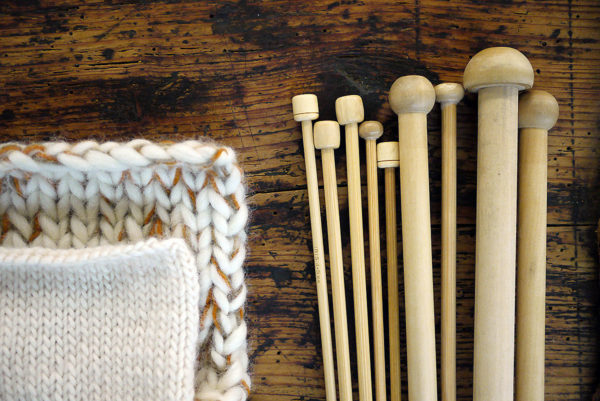Knitting – Particularities
Knitting is a textile production method known since very early days, and it can be described as the process of creating a piece of fabric by interlocking a continuous thread using needles.
This particular technique allows to create an elastic and more flexible fabric than a woven one made with the same kind of fibers.
It can be practiced almost everywhere – public transport, cafés, at the doctor’s in the waiting room – and it’s a fantastic way to apply your creativity. In addition, you don’t need any other tools than needles and yarn.

Although every person may develop his/her own style, there are two traditional knitting methods: Continental and English.
With the English method the yarn is carried in the right hand and the yarn is wrapped around the right needle. In certain regions (Italy, Spain and part of South America) the right needle is placed under the arm allowing the right hand to work more freely.

With the Continental knitting (also called German knitting or European knitting) the yarn is held by the left hand and the right needle “picks up” the stitches. Compared to the English knitting, this method can be done at great speed because hands require fewer movements to make a stitch.

Apart from the cast-on row (the foundation row), all pattern stitches are constructed upon the combination of two basic stitches: knit and purl. Both stitches can be worked with the two traditional methods obtaining equal results.
Regarding the tools, there are different types of knitting needles available in a great variety of materials and sizes. The size of the needle depends on the diameter.
The picture here shows a few examples:
1. Single-pointed, extra-long wooden needles, ideal for jackets and pullovers when using the Enlgish method. The wood absorbs humidity from hands and is good for keeping slippery yarns in place.
2. Plastic needles are light-weight and rather cheap.
3. Bamboo needles are also light weight and smooth.
4. Acrylic needles have a slippery surface and are a bit stronger than the plastic ones.
5. Metal needles are good for rougher yarns. They are usually more expensive but last a lifetime.
6. & 7. Double-pointed plastic and metal needles are used to knit circularly, usually socks, gloves and beanies.
8. Round needles are also used to knit in the round. A flexible plastic cable connects two needle points. The cables are available in different lengths (usually 40, 60, 80, 120 or more cm).
9. Stitch holders are often used to hold a number of stitches that later on will be worked in a special way.
Knitting in the round presents a few advantages: while in flat knitting you must work back and forth and afterwards join together the different parts, in circular knitting there are no seams, you work in a continuous round, and you are always facing the right side of the fabric.
Regarding the materials, wool is the most used natural fiber: insulating, elastic, durable and easy to dye. Merino wool is produced by the sheep with the same name. Other natural (protein) fibres are mohair, cashmere, alpaca, angora and silk.
Among the vegetal fibres, cotton is the most preferred fibre. It is not as elastic as wool and it shows imperfections more easily when knitted. Linen, ramie and hemp can also be hand knitted.
Acrylic belongs to a different group of fibres: man made fibres. It imitates wool but is heat-sensitive and nonabsorbent. On the other hand it is lighter, cheaper and not attacked by moths. Other synthetic fibres in the market include polyamide, polyester, polypropylene, rayon and acetate.
Knitting as an activity is also known for its health benefits: the repetitive movements of the hands help reduce stress and soothes the mind.
From the sustainable point of view, when you knit you can “splurge” on high quality yarns for an exclusive, one of a kind item that will last many years. You can also re-knit old pullovers and scarves, or even over-dye the yarn and create an entirely new garment.
Join our next beginner’s knitting course in Lucerne, whether you speak German, English or Spanish. Please apply here.


